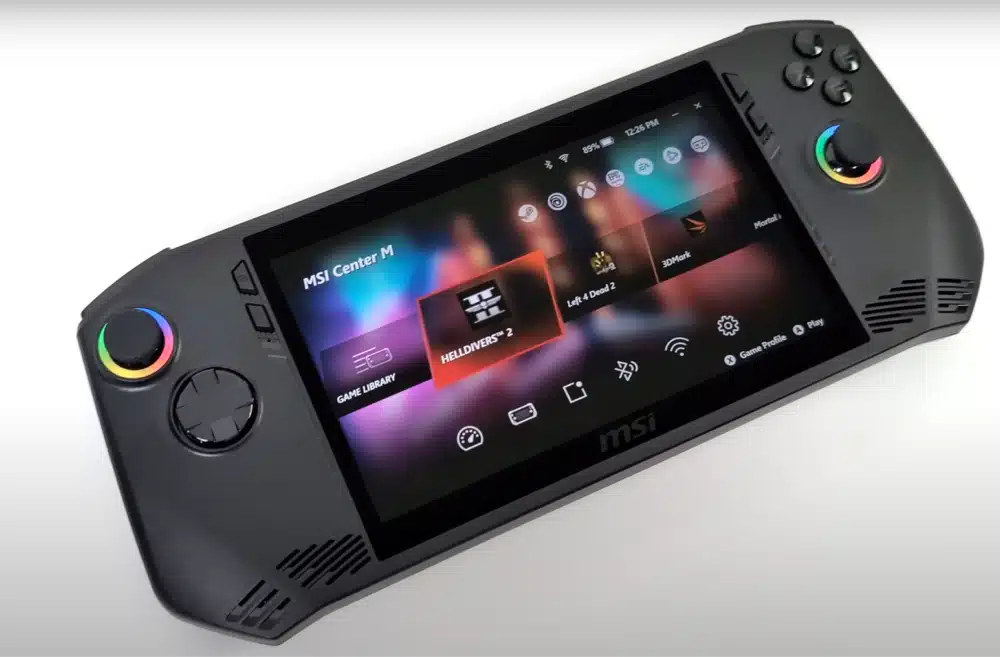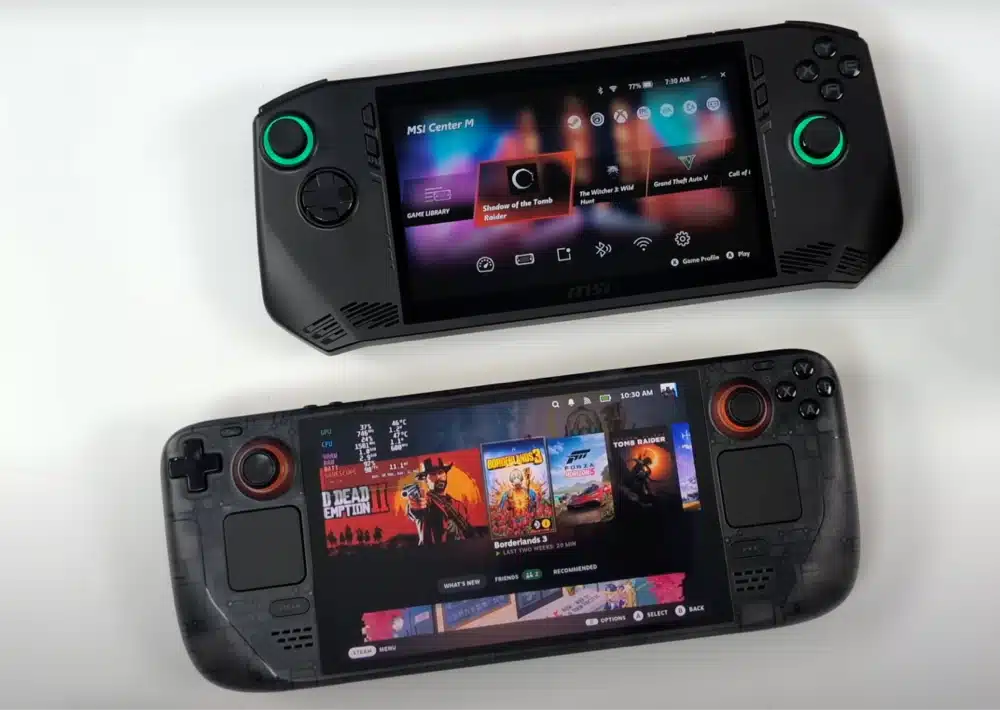The MSI Claw is a new Steam Deck alternative, but is it the option everyone has been waiting for? In this Steam Deck OLED vs MSI Claw comparison guide, I’ll go through each device in detail and help you pick the right one.
I’ll compare key details like:
Display size
Hard drive sizes
CPU
Performance in key games!
If you are in a rush, use the buttons below to buy your handheld gaming PCs today.
Comment below and let me know what you think!
What is the Steam Deck?

The Steam Deck is a PC gaming handheld developed and launched by Valve Corporation in early 2022. It is battery-powered and comes with a 7-inch screen. You can play most games from the Steam store on the deck and over 9,000 titles are officially supported.
The Deck has a full controller scheme, two haptic mousepads, and four configurable rear buttons. This gives you the flexibility to play games in whatever format you want.
The Deck is also popular for game emulation. You can load emulators and ROMs onto it and play downloaded games from nearly any console. Playstation 2 games and anything earlier than that work really well on the console. Some PS3 and Nintendo Switch games are also supported. Nintendo Switch games also work great!
There are different Steam Deck accessories on the market that you can purchase to improve your gaming experience, including screen protectors and protective cases.
How to Buy
The Deck can be purchased from the official Valve store. Beware that there is an Amazon seller who has the Deck posted on there for higher than the retail price.
Click the link below to make your secure and legit purchase:
https://store.steampowered.com/steamdeck
What is the MSI Claw?

The MSI Claw is another handheld gaming PC. This device brings another direct Steam Deck competitor to the market. Powered by an Intel Core Ultra processor and coming in three different options, the MSI Claw offers smooth performance and is one of the most powerful gaming handhelds available.
Priced up to $800, the MSI Claw provides options based on your performance requirements and budget. It features four performance modes, which allow you to optimize power consumption and performance based on your immediate needs. The battery life is about an hour and a half, but you can get close to two hours in low quality mode.
The MSI Claw offers several benefits, including customizable performance settings, ample storage options, and a high-quality build. It runs on Windows 11.
Models
The MSI Claw is available in three different models. To help you decide, here are the main options and their specifications:
512 GB with Intel Core Ultra i5
Storage: 512 GB
Processor: Intel Core Ultra i5
Price: $699
512 GB with Intel Core Ultra i7
Storage: 512 GB
Processor: Intel Core Ultra i7
Price: $749
1 TB with Intel Core Ultra i7
Storage: 1 TB
Processor: Intel Core Ultra i7
Price: $799
The primary differences among these models are in their storage capacities and processors. The i5 variant provides a more budget-friendly option with solid performance. The i7 variant, particularly the 1 TB model, are for gamers who want enhanced performance and greater storage capacity.
Modes
The MSI Claw features four distinct performance modes designed to optimize the device’s power consumption and performance to suit whatever type of game you are playing.
AI Engine Mode
This mode leverages artificial intelligence to balance performance and power consumption dynamically. It aims to provide an optimal gaming experience by adjusting settings in real-time based on the game’s demands.
Balanced Mode
Recommended by MSI, this mode strives to offer a good compromise between performance and battery life. It is designed for general use, ensuring smooth gameplay and reasonable battery longevity.
Performance Mode
This mode prioritizes maximum performance, drawing more power to ensure the highest possible frame rates and smooth gameplay. It is ideal for demanding games where performance is the top priority, although it results in faster battery drain.
Super Battery Mode
This mode extends battery life by significantly reducing performance and turning off RGB lighting. It is suitable for less demanding tasks or games and for situations where preserving battery life is crucial.
These four modes explained above allow you to switch between different settings based on your immediate needs, whether you want to maximize gaming performance or extend battery life during long gaming sessions.
Steam Deck OLED vs MSI Claw
Processor
The processors on the Steam Deck OLED and the MSI Claw have a few distinct differences. The Steam Deck OLED boasts a custom AMD APU with Zen 2 architecture, which offers high performance for a handheld device.
This architecture is renowned for its efficiency and power and I’ve always been impressed with how smooth gameplay is across various titles. Anyone with a Steam Deck will probably agree with me.
On the other hand, the MSI Claw features options with Intel Core Ultra i5 for the 512 GB model and Intel Core Ultra i7 for the 1 TB model. While these Intel processors provide strong performance, they don’t quite match the efficiency and optimization of the custom AMD APU found in the Steam Deck OLED.
Including two different processors in their lineup is questionable too, since it is hard to optimize for multiple processors.
The original Steam Deck LCD is the exact same as the OLED version, except that the display is LCD instead.
Winner: Steam Deck

RAM
The Steam Deck OLED and MSI Claw have 16 GB of LPDDR5 RAM, ensuring smooth multitasking and gaming performance.
Winner: Draw
Hard Drive Size
The Steam Deck OLED offers storage capacities of 512 GB or 1 TB, providing ample space for a vast library of games. With generous storage options, I am confident that I can carry my favorite titles wherever I go without worrying about running out of space.
Similarly, the MSI Claw offers 512 GB and 1 TB storage capacities, mirroring the Steam Deck OLED storage choices. This means that users of the MSI Claw also have the flexibility to choose a configuration that suits their storage needs and preferences.
Winner: Draw
Display
The Steam Deck OLED features a 7.4-inch diagonal HDR OLED display with a resolution of 1280 x 800. It supports a refresh rate up to 90 Hz, which ensures smooth and fluid gameplay.
On the other hand, MSI’s handheld boasts a 7-inch 1920 x 1080 IPS display with a 120 Hz refresh rate. The higher 1080p resolution offers a sharper and smoother gaming experience despite being slightly smaller. The 120 Hz refresh rate takes the gaming experience to the next level, providing buttery smooth motion that enhances every frame.
Whether a small screen device needs 1080p video quality is up for debate. It limits the battery life in the MSI Claw and I don’t think users really want 1080p quality in 7 inches.
Winner: Steam Deck
Weight
In terms of weight, the Steam Deck OLED comes with 640 grams for the 512 GB and 1T model. The two models feel lightweight and well-balanced. Its ergonomic design ensures that it remains comfortable for extended gaming sessions.
On the other hand, the MSI Claw weighs in at 675 grams for all the models. While this isn’t significantly heavier than the Steam Deck OLED, I can feel more heft when holding it. The MSI Claw’s weight gives it a solid, substantial feel, which some gamers might appreciate for its robustness.
Overall, while both devices are relatively close in weight, the Steam Deck OLED’s lighter profile, especially at the lower end of its weight range, offers a slight advantage in terms of portability and comfort.
Winner: Steam Deck

Battery Life
Comparing the battery life of the Steam Deck OLED and the MSI Claw reveals some interesting differences. When I tested the Steam Deck OLED, I found that its 50Wh battery provides a solid range of gameplay, from about 3 to 12 hours, depending on the game’s demands and the settings used. In a typical session, with the display at full brightness and running a moderately demanding game, I comfortably get around 3 hours before recharging.
On the other hand, the MSI Claw, with its 53Whr battery, doesn’t quite match up to the Steam Deck OLED’s endurance. When using the device in its Balance Mode, which MSI recommends, I get roughly an hour and 27 minutes of playtime with 720p resolution and 100% brightness. Even when I switch to the Super Battery Mode, which turns off the RGB lighting to conserve power, the best I manage is about an hour and 51 minutes.
For battery life, the Steam Deck OLED outperforms the MSI Claw. The Steam Deck OLED’s extended playtime means fewer interruptions for recharging, making it a more convenient choice for on-the-go gaming.
Winner: Steam Deck
Steam Deck OLED vs MSI Claw Game Comparison
Cyberpunk 2077
While playing Cyberpunk 2077, the Steam Deck OLED provides a more stable and playable experience. Despite the game’s notorious resource demands, the Steam Deck OLED runs relatively smoothly. In my hands-on testing, there was minimal stuttering, and the game maintained a playable frame rate, thanks to the efficient optimization of the Steam Deck’s custom AMD APU and robust GPU.
On the other hand, the MSI Claw struggled significantly with Cyberpunk 2077. Using its Balance Mode, which MSI recommends, the game was marred by frequent hitching and stuttering, making the experience quite frustrating. The performance modes didn’t offer much improvement, with the average frame rate hovering around 32 FPS but suffering from severe frame pacing issues that disrupted gameplay.
Overall, Cyberpunk 2077 is almost unplayable on the MSI Claw compared to the smoother experience on the Steam Deck OLED.

Forza Horizon 5
In Forza Horizon 5, the performance gap narrows a bit. The Steam Deck OLED continues to impress with smooth gameplay and vibrant visuals, thanks to its HDR OLED display and efficient power management. The game ran fluidly, and I could enjoy the fast-paced racing without noticeable lag or stutter.
The MSI Claw fared better with Forza Horizon 5 than with Cyberpunk 2077. In Balance Mode, it delivered a decent gaming experience with an average frame rate of around 62 FPS. There was less stuttering compared to Cyberpunk, making the game more enjoyable. However, occasional power limit issues and the need to adjust settings frequently detracted from the overall experience.
The Steam Deck OLED still held a slight edge regarding consistency and overall gameplay smoothness.

Horizon Zero Dawn
Regarding Horizon Zero Dawn, the Steam Deck OLED demonstrated its superior optimization. The game looked stunning on the OLED screen, with rich colors and deep blacks enhancing the visual experience. Performance-wise, the Steam Deck OLED maintained a stable frame rate, making for a smooth and immersive journey through the post-apocalyptic world of Horizon Zero Dawn.
The MSI Claw, while capable, could have performed better with Horizon Zero Dawn. The average frame rate in Balance Mode was around 39 FPS, but the game experienced noticeable dips and occasional stuttering. Performance Mode slightly improved the frame rate to about 40 FPS but still fell short of providing a consistently smooth experience.
Compared to the Steam Deck OLED, the MSI Claw’s performance felt less polished and more prone to interruptions.

Conclusion
In conclusion, both the MSI Claw vs Steam Deck offer compelling features for handheld gaming, but each has its strengths.
The Steam Deck OLED version excels with its custom AMD APU, providing superior efficiency and better performance, particularly for demanding games. Its OLED display enhances visual quality, and its impressive battery life ensures longer uninterrupted gaming sessions.
The MSI Claw stands out with its customizable performance modes and higher resolution display compared to the Steam Deck. However, its battery life and performance in high-demand games fall short compared to the Steam Deck OLED.
The Steam Deck is the clear winner here. MSI gives a decent alternative to other Windows handhelds like the Rog Ally, Pimax Portal, and Logitech G-Cloud.



